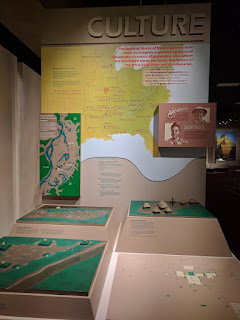Past couple of years, I traveled to many small towns in the USA. I met with different native people, who are all classified under a bucket, Native Americans, formerly known as Indians. As I explored more history, I quickly realized that many different cultures and tribes existed and still exists in the USA. One common amongst all of them was the conflict with European settlers, which led to their downfall. However, Cahokia Mounds is an exception.
 |
| A map of Mississippian culture civilizations |
Last labor day, I visited Effigy mounds in Iowa. Different native people living in on the banks of Mississippi river used to make mounds, in variety of shapes and sizes. Many theories exist of their purpose: each as likely as the other. When urban expansion hit Midwest, several thousands of the mounds were destroyed to make room for modern cities and towns. Some of them preserved and protected, like effigy mounds. I will probably write a separate account of effigy mounds.
Today, Cahokia mounds site has many well-marked trails. Most of the mounds are covered in vegetation. Turkeys, dears and other wildlife frequent the area. I visited during the coldest day of the winter, so visitors were limited in numbers. A museum inside the visitor center shed some light on the culture, weather, location and history of Cahokia as well as its relationship to other Mississippian civilizations at the time.



Archeologists could not find enough evidences to determine the possible reason for downfall of a prosperous civilization. The possibilities were war, natural disaster, failure of leadership, and cultural changes. War and natural disasters seemed unlikely as 104 mounds stood intact. Failure of leadership could have driven away people. Most likely reason was the cultural changes. What does that mean?
The land was very fertile where Cahokia was. The citizens mastered the art of farming. They soon were growing more food than they needed. As a result, some citizens diversified into tool making, performing, advising and other professions. Over the time, more and more people moved away from the basic task of growing food. Probably, they ran out of farmers and food leading to downfall of the city. The situation is quite similar. The world is full of non-farming people like me, who are wasting time in regulation, politics or laziness. Aliens and robots are far reality. Our doomsday is scripted by us by ignoring our basic needs.
 |
| A survey of possible downfall reasons of Cahokia |
Visit Cahokia Mounds, largest archeological site in the USA: https://cahokiamounds.org
No comments:
Post a Comment